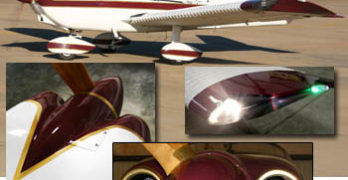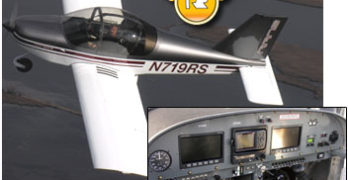The Beaver and Chinook ultralight-like aircraft are arguably two of the bestknown
lightweight designs coming from Canada. Aircraft Sales and Parts, more
commonly known as ASAP, is the company that rescued and now manufactures
and sells these designs, along with a powered parachute from its sister company,
Summit Powered Parachutes. The tale of ASAP’s involvement with the Chinook
and Beaver offers insight into ultralight progress – Canadian style.
A History Lesson
Perhaps the most famous ultralight
to come out of Canada is the Beaver.
With a reported 2,200 flying units
since the early 1980s, it’s a successful
design. However, due to corporate
missteps by the companies that
owned the brand, the Beaver series
was nearly lost. Originally, the Beaver
models were manufactured by
Spectrum Aircraft Inc. Reorganization
left the ultralight in the hands
of a company called Beaver RX Enterprises.
In 1993, that company closed
its doors and stranded thousands of
Beaver aircraft owners, along with
all the dealerships that sold and serviced
them.
Search Results for : MG 21
Not finding exactly what you expected? Try our advanced search option.
Select a manufacturer to go straight to all our content about that manufacturer.
Select an aircraft model to go straight to all our content about that model.
A Sport Bike of the Air
First weight-shift S-LSA sets the bar high
In street vernacular, the term
“crotch rocket” refers to a lean,
lightweight, high-performance
motorcycle. Sometimes called sport
bikes, these machines have become
radically snazzy in modern years by
the addition of rakish body panels.
Sport bikes accelerate like a rocket.
They corner tightly, and they turn
heads wherever they go.
The first weight-shift trike to earn
special light-sport aircraft (S-LSA) approval,
the Air Creation Tanarg might
be compared to just such a vehicle. In
fact, that’s precisely how its French
manufacturer describes its newest
machine.
Yet, while sport bikes are touchy
and have less margin for error than
other motorcycles, Air Creation’s flying
sport bike is highly stable with predictable
handling. Compare Tanarg’s
performance to other trikes, and it
comes out as a top-of-the-line entry.
The name Tanarg comes from the
highest mountain range in the Ardeche
region of southern France, not
far from the Air Creation factory.
Surprising Value in an Unsurprising Design
On September 1, 2004, when the Federal Aviation Administration (FAA) released the long-anticipated Sport Pilot and Light-Sport Aircraft regulations, a new aviation segment called light sport aircraft (LSA) was created. Some saw LSA as a bridge between ultralights and general aviation aircraft, but are LSA so different from ultralights? The answer is a mixed yes and no.
Yes, many aircraft look different in that the extra weight they may possess allows them to have full composite fuselages, a panel full of instruments even including fancy glass cockpit hardware, plus they can be delivered ready to fly even as 2-seaters. That’s different than our ultralight trainers or our amateur-built recreational aircraft that resemble those trainers. Prices for these light sport aircraft have pushed them beyond the budgets of many pilots.
On the other hand, these aircraft needn’t be all that different from ultralights. The new rule doesn’t require that they weigh the maximum 1,320 pounds.
Spiffy New Thorpedo…IndUS Aviation’s LP Series
IndUS marketing geniuses called their program “Refresh ’08,” but perhaps it ought to be “Renew ’08?” The changes on which IndUS staffers have long labored gave the proven design its smartest look yet. Here’s a neat trick for what may be the oldest SLSA design in the fleet, what with Serial Number One T-211 turning 61 in 2007 (“and it’s still flying all over the place”). *** In January 2007, IndUS announced a partnership with LoPresti, the Speed Merchant people who helped Piper and several other GA brands extract more performance from their airplanes without airframe modifications. IndUS left the partnership but a clever team at the Dallas company took up the innovation effort and produced impressive results. *** The Thorpedo shown at Sebring 2008 sported a snazzy new engine cowl treatment, light-emitting wing tips including built-in landing lights, and streamlined gear leg fairings.
ZJ Viera Part 103 Composite Excites Sebring Crowd
Alert: This article is dated and some links may no longer lead to the desired destination. —DJ 0121
Maybe you’ve heard: “You can’t build a three axis airplane that can safely remain under the 254-pound weight limit.”
Some allege: “You can’t buy a three axis Part 103 ultralight that actually meets the rule.”
I’ve said this many times… WRONG!
You have a few choices for Part 103 airplanes that perform well and they aren’t all trikes or powered parachutes (though several qualifying candidates do come from these segments). I’ll soon post fresh articles on the Kolb FireFly and Phantom X-1. Each can meet Part 103.
Now, we have what may be the first all-new Part 103 ultralight in many years. ZJ Viera was designed in Europe by Marek Ivanov, CEO of Interplane Aircraft (photo). At Sebring 2008, plenty of attendees spent time examining the two examples present; one was the original monowheel (which I tend to prefer) and a tri-gear variation.
Year-End Market Shares; LSA Grows 98% in 2007
Light-Sport Aircraft ended a successful year in 2007 with sales up 98%, registering 565 new fixed wing airplanes for the calendar year for a total of 1,118 airplanes. Including weight shift, powered parachutes, and gliders (no gyro or lighter-than-air yet), total registrations for the year hit 720, up 120% over the previous year close and totaling 1,395 LSA nationwide. For comparison, the general aviation industry produced as many single-engine (SE) piston airplanes each quarter as the LSA industry did all year, and GA is expected to ship more than 2,200 SE pistons for 2007. Can LSA match that performance in the next two or three years? My forecast says, “Yes!” I estimated 600 for 2007 (we hit 92% of that target). I’ve forecast 1,000 units in 2008 and doubling that again in another year or two. If I’m right, LSA may someday meet or exceed all other SE piston sales in the USA.
Dynamic Spins Into SLSA; Unveiling at Sebring
SEBRING 2008 UPDATE — Sport Aircraft Works, importer and marketer of the fast-selling SportCruiser, will announce an LSA version of their Dynamic WT9. Previously, the retractable speedster (174 mph max cruise) was only available as a kit but the Slovak designer decided to pursue American SLSA certification at 550 kg (1,212 pounds). [UPDATE: Dynamic won SLSA approval on January 8th.] *** As part of their effort to meet the standards, the Aerospool Dynamic underwent spin testing by company test pilot, Jozef Chupek. “He finished this task without any undesirable control behavior,” reported the company. Testing was done in a variety of CG load and control input configurations. “All testing situations were recoverable using normal spin recovery procedures,” Aerospool added. “Spin test flights were flown with our standard aircraft; we didn’t make any special modifications [other than] safety elements such as spin recovery parachute and ejectable cockpit.” Testing was observed by members of the Slovak Civil Aviation Authority.
Oh, Wait! One More in 2007…Rans S-19LS
As we bid farewell to 2007, up popped one of America’s top kit producers: Rans. During the year the industry reached number 65 in Special Light-Sport Aircraft approved. Randy Schlitter sent a note saying, “We achieved SLSA status for the S-19LS on December 21st.” He added, “The S-19LS is the first all new aircraft made and designed in the USA specifically for the light sport category to receive SLSA status since the ruling went into effect.” S-19LS relied heavily on CAD/CAM methods. “In fact we never built a prototype; the first aircraft was production tooled,” continued Schlitter. *** S-19LS features the 100-hp Rotax 912ULS, an all-glass cockpit, and a $110,000 introductory price. Since late 2005, Rans has successfully produced the $85,000 S-7LS Courier. Delivery of the first S-19LSs should begin in 10 months, according to the company. If demand warrants, the Hays, Kansas company projects building 50 a year within 12 months, and possibly doubling output later.
Fast As a South African Cheetah, The Kit
We have many great airplanes among the 62 models in the SLSA fleet. But the price tag for some of these beauties could motivate you to consider a kit. Why not? Homebuilts and Ultralights proved many folks could manage the build effort. Organizations like EAA are ready to help. *** With all that in mind, Midwest Sport Aviation would like you to consider the Cheetah XLS they import from Rainbow Aircraft in South Africa. The fixed wing aircraft shares traits with the Ikarus C-42, for example, both use sewn Dacron coverings. Cheetah also resembles the French SkyRanger which remains available in the USA. Like SkyRanger, Cheetah is a fast-build kit. *** Trike expert Mike Blyth formed Rainbow Aircraft in 1995 with his Ukrainian partner, Vladimir Chechin. Blyth sold his interest a couple years ago. Cheetah first flew in September 2001; today Rainbow turns out six aircraft a month.
Sport Aircraft Works Revs Up; Hits 3 Benchmarks
October 2007 was the One for Sport Aircraft Works, U.S. importer of Czech Aircraft Works (CZAW) airplanes. They registered #41 SLSA with FAA, they took order #101 for their SportCruiser, and they sold a pair of SportCruisers to the #21 school to adopt the brand and become a Sport Aircraft Pilot Center. Customer deliveries reached 40 for CZAW’s best-selling SportCruiser. Sport Aircraft Works Director of Sales Bob Anderson said, “SportCruiser is one of the few aircraft sold as a Light Sport Aircraft that was designed for the 1,320-pound weight limit,” that is, it wasn’t scaled up from a European 992-pound (450 kg) microlight. The company partners with Gleim Publishing for training documents in their Sport Aircraft Pilot Centers. *** Sport Aircraft Works also represents the Aerospool WT-9 Dynamic which can be homebuilt as a retractable speedster or flown by a Sport Pilot with fixed gear and a prop that translates speed into more climb.
- « Previous Page
- 1
- …
- 80
- 81
- 82
- 83
- 84
- …
- 94
- Next Page »











